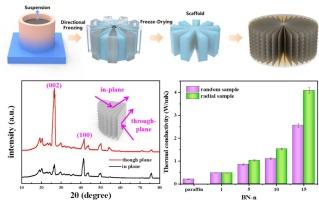Design of phase change materials with radially assembled 3D boron nitride network for enhanced thermal energy storage
IF 8.9
2区 工程技术
Q1 ENERGY & FUELS
引用次数: 0
Abstract
Phase Change Materials (PCMs) have attracted significant attention due to their high latent heat and isothermal phase transition properties. However, their large-scale application in daily life has been limited by challenges such as low thermal conductivity and insufficient shape stability during phase transitions. In this study, boron nitride (BN) and chitosan (CS) aerogels were employed as 3D skeleton materials using an ice-templating method, where the controlled growth of ice crystals in radial pattern enabled the ordered alignment of thermally conductive fillers. A paraffin-based composite material was successfully fabricated. Compared with pure paraffin, the incorporation of only 15.11 vol% BN resulted in a 1944.5 % increase in thermal conductivity (4.089 W/mK). Furthermore, this value was 59.54 % higher than that of composites with randomly dispersed BN at the same concentration. Consequently, the composite exhibited excellent thermal cycling stability, a latent heat storage capacity exceeding 175.8 J/g, and effective leakage prevention at high temperatures, while maintaining an ultrahigh electrical resistivity (2.3 × 1011 Ω·cm) and low dielectric loss. This work presents an innovative approach for developing thermally conductive and shape-stable composite PCMs for energy storage applications.

径向组装三维氮化硼网络相变材料的设计
相变材料由于具有高潜热和等温相变的特性而受到人们的广泛关注。然而,它们在日常生活中的大规模应用受到诸如低导热性和相变过程中形状稳定性不足等挑战的限制。本研究采用冰模板法,将氮化硼(BN)和壳聚糖(CS)气凝胶作为三维骨架材料,控制冰晶以径向模式生长,使导热填料有序排列。成功制备了石蜡基复合材料。与纯石蜡相比,加入15.11 vol% BN后,导热系数提高了1944.5% (4.089 W/mK)。在相同浓度下,该值比随机分散的BN复合材料高59.54%。因此,该复合材料具有优异的热循环稳定性,潜热储容量超过175.8 J/g,在高温下有效防止泄漏,同时保持超高电阻率(2.3 × 1011 Ω·cm)和低介电损耗。这项工作提出了一种创新的方法来开发用于储能应用的导热和形状稳定的复合pcm。
本文章由计算机程序翻译,如有差异,请以英文原文为准。
求助全文
约1分钟内获得全文
求助全文
来源期刊

Journal of energy storage
Energy-Renewable Energy, Sustainability and the Environment
CiteScore
11.80
自引率
24.50%
发文量
2262
审稿时长
69 days
期刊介绍:
Journal of energy storage focusses on all aspects of energy storage, in particular systems integration, electric grid integration, modelling and analysis, novel energy storage technologies, sizing and management strategies, business models for operation of storage systems and energy storage developments worldwide.
 求助内容:
求助内容: 应助结果提醒方式:
应助结果提醒方式:


